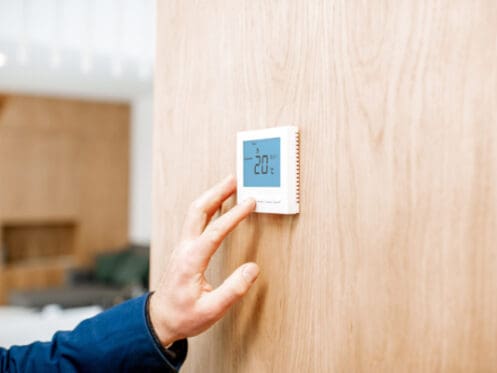Summer can be unbearable without an air conditioner, but the good news is that you don’t have to break the bank to stay cool. There are many ways to save on cooling costs. Thermostat control is a big one. Understanding how to properly utilize your thermostat can make all of the difference in your comfort levels at home. It can also reduce your energy consumption, lower your monthly bills, and stop you from constantly fiddling with the dial.
The Best Thermostat Temperature for Summer
According to the U.S. Department of Energy, the best temperature for your home in the summer is 78 degrees Fahrenheit. However, many people find this number quite high, and other institutions have recommended lower temperature ranges for comfortable living. For example, the National Sleep Foundation says that around 65 degrees Fahrenheit is ideal for a good night’s rest. OSHA recommends between 68 degrees Fahrenheit and 76 degrees Fahrenheit for offices and other workspaces.
What’s the right temperature for your own household? It’s a question that only you can answer, and that answer will depend on factors like budget, local weather patterns, desired energy savings, type of HVAC system in your home, and more.
How Thermostats Work
To get the most out of your thermostat, you need a basic understanding of how they operate.
The first thing to know is that there are multiple types of thermostats. The broadest category is “mechanical” versus “digital,” with the former being more common in older homes and the latter being the standard for modern HVAC systems.
Other types of thermostats include:
- Programmable
- Non-programmable
- Smart/Wi-Fi controlled
There are even homes with mercury thermostats. These are quite old, and the U.S. has banned their sale, but they aren’t illegal to still own or operate.
The Most Common Mistake When Using a Thermostat
It’s hot. You’re dripping sweat. You come home and turn the air conditioner on, adjusting the thermostat to a nice low number so that you’ll cool off more quickly.
Did you know that this is futile? Extreme temperatures won’t make your heating or cooling systems work faster. They operate at the same rate of efficiency regardless of what temperature they’re set to, and this rate can’t be changed. It’s based on the law of thermal expansion.
How long does it take to cool a room? This depends on a variety of factors, including room size, but it’s generally somewhere in the range of one to three hours for a 10 degrees Fahrenheit difference.
In other words, if you’re trying to cool your home from 80 degrees Fahrenheit to 70 degrees Fahrenheit, it’ll take a few hours regardless of the temperature that you set on your thermostat. Putting it at 60 degrees Fahrenheit or 65 degrees Fahrenheit won’t cool you down any faster. Just put it on your desired temperature, and be patient.
Everyday Tips for Lowering Your Air Conditioning Bill
The easiest way to cut back on cooling costs is to set your thermostat higher. Even a small change of a few degrees can result in long-term savings, and you’re unlikely to notice any real difference between 66 degrees Fahrenheit and 68 degrees Fahrenheit. Most people aren’t that sensitive to temperature.
How much money can you save by running your air conditioner a little warmer? It’s estimated that you can hold on to anywhere from 1-5% annually with every degree above 72 degrees Fahrenheit. It might not sound like much, but depending on your annual energy costs, this small percentage could translate to hundreds of dollars in savings. Keep in mind that the average homeowner spends more than $1,000 per year on heating and cooling.
There are also ways to cool off besides using an air conditioner. You can install a ceiling fan and make sure that it’s rotating counterclockwise to push cold drafts down. You can use a dehumidifier to draw moisture out of the air and feel less hot and sticky. If it’s a nice, windy day, you can turn off the air conditioner entirely and open a window.
The Benefits of a Programmable Thermostat
Another handy tip for saving costs on air conditioning is installing a programmable thermostat. These tech-savvy gadgets can remember your settings, create schedules for turning themselves on and off, and adjust their temperatures as instructed.
If you get home from work at 6 p.m., for example, you can program your thermostat to kick on the air conditioner at 5 p.m. every day, allowing you to walk in the front door to a blissfully cool home. If you don’t need as much air conditioning at night because you sleep with a box fan running, you can program your thermostat a little warmer during nocturnal hours, having it cool things off again when you wake up.
Smart Thermostats and Energy Savings
Some programmable thermostats are equipped with smart technology. These tend to be top-of-the-line models with lots of fancy features such as remote access, energy reporting, and diagnostic alerts.
How can smart thermostats save you money? For starters, they’re programmable thermostats that can remember your settings and adjust themselves accordingly. Some even boast intuitive or predictive technology that can anticipate your needs without you having to lift a finger. They might track weather reports, for example, and make themselves cooler during particularly hot days. They might recognize patterns in your thermostat usage and start to tweak their temperatures automatically.
They also offer greater temperature control than other thermostats. Instead of general settings like “low” and “high,” you’ll be able to input exact degrees. Some thermostats that are controlled via smartphone have things like sliding bars that you can move left and right with the utmost precision.
In the case of remotely controlled thermostats, they’ll also allow you to change home temperatures without the need for official, preset programs. If there’s a sudden heat wave while you’re at work, for example, you don’t need to despair because you didn’t program your thermostat to turn on before you get home. You can just reach for your phone, start your air conditioner remotely, and have it going when you return home.
Installing a Programmable Thermostat
If you’re interested in a programmable thermostat for money and energy savings, you’ll want to reach out to an HVAC company. It isn’t something to install yourself. Not only are certain types of thermostats incompatible with certain HVAC systems, but they can also require expert-level knowledge to properly connect. This is especially true if you’re upgrading from a mechanical thermostat to a digital or programmable one.
Keep in mind, too, that thermostats control heating as well as cooling, so there are furnaces, pilot lights, gas lines, and other hazards to consider. All in all, it’s better to have a trained HVAC technician handle your thermostat installation.
How to Save Money With Your Thermostat
Don’t let energy bills bring you down this summer. Instead, utilize smart thermostat practices to keep costs low while also staying cool and comfortable. If you need help with any thermostat-related issues, contact us at First Choice Plumbing, Heating & Air Conditioning in Metuchen. We’re experts in air conditioners, and we also offer services related to heating, plumbing, air quality control, and more.




